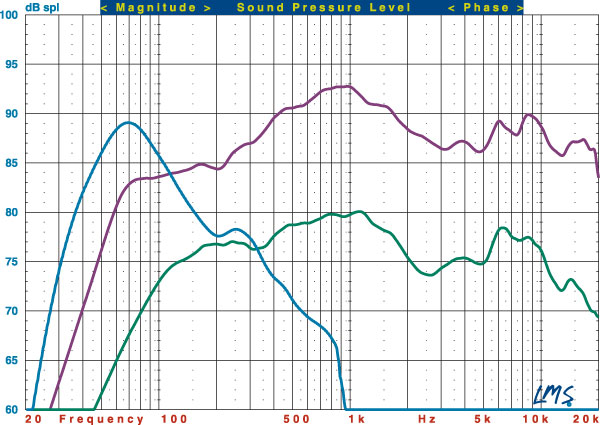Gallo Nucleus Classico CL-2 Speaker System HT Labs Measures
Satellite Sensitivity: 90 dB from 500 Hz to 2 kHz
Center Sensitivity: 92 dB from 500 Hz to 2 kHz

This graph shows the quasi-anechoic (employing close-miking of all woofers) frequency response of the CL-2 satellite (purple trace), CL-C center channel (green trace), and CLS-10 subwoofer (blue trace). All passive loudspeakers were measured with grilles at a distance of 1 meter with a 2.83-volt input and scaled for display purposes.
The CL-2’s listening-window response (a five-point average of axial and +/–15-degree horizontal and vertical responses) measures +2.82/–5.55 decibels from 200 hertz to 10 kilohertz. The –3-dB point is at 288 Hz, and the –6-dB point is at 115 Hz. (Please note that these points are significantly higher than might be expected due to the elevated response in the 500 Hz to 2 kHz band we use as our sensitivity reference.) Impedance reaches an in-band minimum of 2.82 ohms at 20 kHz and a phase angle of –48.48 degrees at 13.1 kHz. Look- ing further, the absolute minimum impedance is 2.32 ohms at 23.5 kHz.
The CL-C’s listening-window response measures +3.07/–3.38 dB from 200 Hz to 10 kHz. An average of axial and +/–15-degree horizontal responses measures +2.70/–5.38 dB from 200 Hz to 10 kHz. The –3-dB point is at 110 Hz, and the –6-dB point is at 86 Hz. Impedance reaches a minimum of 2.67 ohms at 20 kHz, 2.35 ohms at 23.1 kHz, and a phase angle of –38.64 degrees at 13.5 kHz.
The CLS-10’s close-miked response, normalized to the level at 80 Hz, indicates that the lower –3-dB point is at 48 Hz and the –6-dB point is at 41 Hz with the Bass Boost switch set to its maximum of +6 dB. The upper –3-dB point is at 103 Hz with the Crossover switch set to Bypass. —MJP




























































